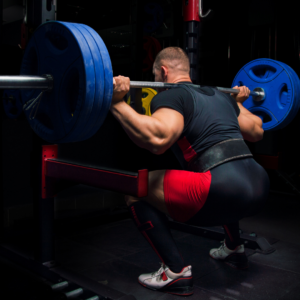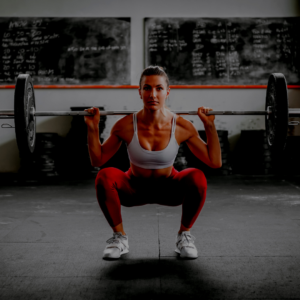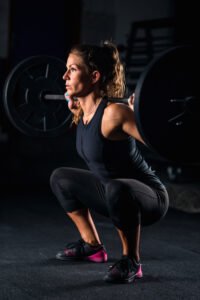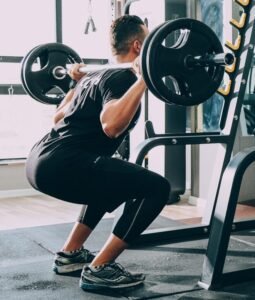Fix Your Fundamentals: Essential Lifts 101: The Squat
Our bodies are made to squat. It’s a foundational movement – one of the most basic functional movements, and therefore one of the most effective and imperative to perfect and to train consistently.
Even a simple bodyweight squat trains just about every muscle in the core and lower body. But it goes beyond that, – the squat puts to work just about every body part from head to toe. It’s an incredible compound movement that builds muscle, burns calories and fat, boosts protection from injury, improves athleticism, mobility, and posture
The squat is one of the ‘Big 3’ lifts, universally considered an essential part of every program for good reason – it is an incredibly thorough lift that puts your entire body under the best kinds of stress, and forces muscles from head to toe to work overtime. If you use it wisely, it will unlock unreal progress, no matter your goals.
And you’ll never lack for variety – squats have a staggering number of variations,each with its own specific benefits.
But, squats are probably the lift where we most commonly see bad form. And bad form in a squat is a fast-track to injury, plateaus, missed gains, and joint pain.

What the squat does for you:
The barbell squat lights up your entire body – working over 256 muscles! Front and center are the quadriceps. The hamstrings, glutes, back, core, and to a lesser degree shoulder and arm muscles get the work as well.
No matter why you’re in the weight room, the squat is crucial. For athletes, the squat provides the foundation of speed, power and explosiveness. For bodybuilders, every muscle in the lower body and core is targeted.
Squatting consistently provides immense protection from injury. Your knees, hips and lower back – all vulnerable areas – become stronger, and your bones, especially in your lower body, gain density. Your range of motion can improve dramatically, which allows you to absorb the unexpected. And as you age, which we all will eventually, these things keep your body resistant to deterioration.
There are tons of different ways to squat – perhaps more variations than any other exercise! We’ll examine the entire spectrum in future installments, but this article is focused on the barbell squat – the cornerstone of lower body strength training.

How To squat
Set up
STEP under the bar, which should be racked slightly below shoulder-height. Position the bar so that it rests on the muscles at the top of your back, not your neck. It should not feel uncomfortable when you lift it off.
(Go high or go low? – As an alternative, you can hold the bar slightly lower on your back – push your shoulders back and create a shelf with your delts. You’ll lean slightly forward to keep the bar path over mid-foot. This can be more effective for strength-focused goals, because it will allow you to lift heavier weights. We’ll go deeper into the differences in a future installment.)
GRIP with your hand placement just wider than your shoulders. Start out erring on the wider side, and prioritize your comfort when finding your width. Over time, you’ll aim for as narrow as you can grip the bar while keeping your wrists straight and the weight stable.
the LIFT
STRAIGHTEN your back, keep your eyes ahead, and unrack the weight.
STEP BACK and stabilize – Feet shoulder width, straight forward or slightly angled outward (5-20 degrees).
(Stance angle is a combination of comfort and intent. Try to have your feet facing forward, but if it doesn’t feel natural, a slight outward angle is fine.)
BREATHE deeply into your stomach. Engage your core (brace as if you’re about to get punched in the gut, not holding your breath). Squeeze your glutes.
EYES forward (look ahead, not up!). Feet remain flat. You should be able to wiggle your toes at any time.

LOWER your body, by moving your hips back and down. Keep your knees over your toes. Keep your back straight.
LOWER until your thighs are at least parallel with the ground (hips below your knees). The deeper the squat, the more glutes, the more (3x parallel vs. half) muscle growth in general
DRIVE powerfully through your heels (feet stay flat), to raise up to standing position. Keep your spine neutral, chest up, knees pushing outward.
TIPS
-If you’re struggling with some aspect of the squat, it’s typically a sign of a weakness you should focus on. Lower back pain can mean poor form or a weak core. Knee pain is likely from poor form. If you can’t get low enough, you might want to work on hip mobility or ankle flexibility.
-Slight deviations in form can be okay, such as the angle of and width of your foot placement. Prioritize comfort, but don’t go too far.
-You should be going as low as you can, but at least parallel – hips just below the knee. Anything less drastically reduces what you’re getting out of the exercise. (And if you’re sqatting to get that amazing butt, the deeper the squat, the more glute muscles are activated, and muscle growth increases drastically.)
What to avoid
Feet angled poorly
Feet angled too far outward, or feet too wide or close places undue stress on the knees and hips
Fix:
After you step back from the rack and position yourself, check your foot angle. Squat in front of a mirror if you can.
Knees forward
Knees bending to lower instead of hips moving
Knees Collapsing Inward:
Fix:
Reduce the weights. Also, perform Bodyweight Squats with a mini-band wrapped around thighs just above knees to strengthen the muscles that maintain alignment of the knees with the hips and ankles.
Fix:
Reduce the weight on the bar su__bsequent sets. Focus on sitting your hips back and keeping your chest up.
weight on your toes
It’s important to keep your heels on the ground the entire time you’re squatting. You want your feet flat and weight on them fairly evenly distributed. You should be driving down through your heels – you can’t do that if they’re coming off the ground.
Fix:
Wiggle your toes periodically. You should be able to do this at any point during a squat, and it shouldn’t affect your movement at all.
Rounded back:
Probably the most dangerous and risky form error, rounding your back puts all of the stress of the weight on all of the wrong parts of your body.
Fix:
Pay close attention to head positioning and knee positioning. Keep your eyes straight, and your knees over your toes. If you hit all of your cues, it should be natural to keep a neutral back.
If you still struggle, reduce weight, strengthen your core before adding weight.
Leaning Forward:
Places excessive strain on the lower back.
Fix:
focus on sitting your hips back and keeping your chest up. In addition, perform Bodyweight Squats to improve mobility.
The LAST WORD
The squat is the most foundational movement of strength and athletic development. True progress for any fitness journey starts at the squat rack. From those simply trying to build strength and an impressive physique, to elite athletes vying to run faster, jump higher and generate more power – top-tier squat technique and implementation, and the powerful muscles it develops are absolute difference-makers.
The squat is known as ‘the king of all exercises’ for good reason. It’s a compound movement that recruits almost every muscle group in some way. It builds muscle mass all throughout the body and blasts you to new levels of strength, strength that transfers over to all your other lifts. The squat strengthens your core, develops your lower body strength and size, and protects you from a range of injuries and pain.
Squatting is serious undertaking, a complex exercise with serious risks and manifold rewards. You can use it to rocket through all your goals, shape your body, and unlock incredible levels of athleticism. But if your technique isn’t on point, you risk serious injury, and if you don’t incorporate it wisely into your program you can find yourself stuck hitting plateaus and lifting the same weight for long periods of time.
The game-changer is having an expert by your side to diligently design your program, and help you execute with excellence. With Stronglab, our elite coaches will guide you to perfectly executed, well-used squats and straight to all your goals.
Head straight to our pricing page, or take our quiz to find exactly the right program for you! If you’re in Manhattan, get one-on-one live training or join one of our small groups!


